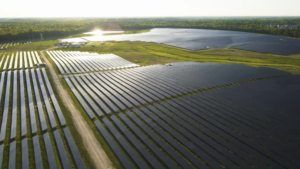Cleaner, Affordable, Reliable – The Pillars to NC’s Energy Future

The outages impacting millions of people across Texas in February, as a deadly winter storm disrupted power supplies and fueled a convergence of secondary crises, revealed the tragic consequences that can stack up when an electric system falters on a massive scale.
That event has raised the question for many: Is North Carolina’s energy system prepared for what the future may bring?
At Duke Energy, we focus on this question every day. After all, businesses and residents across the state depend on us, which is why we’re always thinking about the energy that powers the communities we serve, at the best of times as well as the worst. In this fast-changing environment, we know that the pillars to a resilient energy future hinge on a strategy that can meet the energy needs of today, while planning for the needs of the future.
In this video – and in more detail below – I explain the steps we’re taking in partnership with others, like the NC Chamber and organizations like yours, to provide a smart, forward-thinking energy strategy for North Carolina.

Duke Energy – Toward a Cleaner, More Sustainable Energy Future
Nurturing Clean Energy Goals
Duke Energy and the NC Chamber have long advocated for a diverse energy portfolio for North Carolina that makes the smartest, most environmentally responsible use of available resources. In today’s world, we recognize this means integrating greater levels of renewable energy to provide increasing clean energy and advance our ambitious carbon reduction goals. We know many of you have similar visions for sustainability at your companies. Helping you achieve these goals is at the heart of our strategy as your energy provider.
We’ve already taken significant steps to make North Carolina a national leader in emissions reduction, as we’ve worked over the past two decades to replace many older, less efficient coal units with cleaner burning, more flexible natural gas. As we’ve made these investments, we’ve also created jobs and economic opportunities for local communities and our state. For example, the 2019 replacement of our coal-fired Asheville plant with natural gas, solar, and battery storage facilities created 1,300 jobs and $1.7 million in new property taxes, even as it lowered carbon emissions by 60 percent.
In 2020, we took another determined step forward, engaging a diverse group of stakeholders to develop a comprehensive 15-year plan that will enable us, together as a statewide community, to realize our clean energy goals. The plan maps out six potential pathways that include a wide range of generation portfolios and carbon reduction targets to provide a balanced view of our options as a state. They include substantial increases in solar capacity and battery storage and investments in wind as a viable generation resource. Each pathway keeps us on a trajectory to hit targets of at least 50 percent carbon reduction by 2030 and a net-zero carbon footprint by 2050, with some pathways aiming for even loftier targets.
Ensuring Affordable Prices
Of course, affordability must remain a priority as we transition away from coal to cleaner energy sources. North Carolina now benefits from some of the lowest energy rates in the country, with our residential customers paying about $30 less per month than the national average. A balanced energy transition should protect against rate spikes and support equitable outcomes for all North Carolinians, from single-person households and families to the large manufacturers and agribusinesses that make up the backbone of our economy.
I am honored to serve on the Executive Committee at the NC Chamber, which functions as a state affiliate for the National Association of Manufacturers (NAM). I hear often – on this committee and elsewhere – how important rate stability is for job creators, and especially for those paying industrial energy prices. As you know, there’s a checklist these businesses and industries look to when considering where to expand, and competitively priced energy is high on that checklist.
In order to keep rates as competitive as possible, we must acknowledge the need for energy sources that can be relied on when renewable capacity cannot meet the demand placed on the grid. Flexible, dispatchable natural gas and dependable nuclear power are both cleaner energy sources that can help us fill this near-term need while enabling us to continue working toward our state’s long-range carbon reduction goals.
Investing in a Reliable Grid
The big takeaway from Texas is that continued grid reliability must be central to North Carolina’s energy future. Proactive investments in energy infrastructure can mean the difference between a temporary inconvenience and a catastrophic emergency. Investments in grid modernization and storm hardening are key components of our plans for North Carolina. These investments will mean fewer outages, faster recovery times, and stronger protection from natural disasters and security threats, so that our state will be ready no matter what comes our way.
Texas’ energy crisis was made worse by the state’s de-regulated market, which resulted in some electric retail providers stopping customers’ service on short notice, while customers that retained their power were shocked with astonishingly high energy bills. At Duke Energy, it is our responsibility to provide our customers with reliable, affordable power, and this is reinforced by the oversight of state regulators.
Despite North Carolina being a frequent target of extreme weather – from hurricanes to ice storms to increasingly severe supercell events – we’ve never experienced anything like what happened in Texas. The checks and balances on our state’s energy network are integral to this success.
Owning Our Energy Future
Duke Energy is locally grown and locally headquartered, with more than 16,000 employees calling this state home. Our commitment to investing in a modernized energy future for North Carolina is an extension of our commitment to the overall success of our home state. This includes dedicated support for local suppliers, diverse hiring, workforce development, community enrichment and, of course, job creation in communities across North Carolina.
In this, we are fortunate to have the support of organizations like the NC Chamber and job creators like you, who share our vision for reliable, affordable, cleaner energy here in North Carolina. As we continue to determine our state’s energy future together, I look forward to new opportunities for dialogue to ensure the needs and goals of all stakeholders are considered and accounted for.
Thank you for your partnership, and for placing your trust in us to responsibly lead North Carolina’s energy transition.
Sincerely,
Stephen De May
North Carolina President
Duke Energy